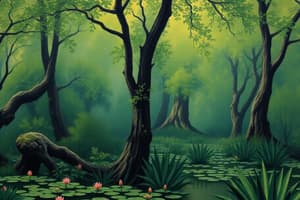Podcast
Questions and Answers
What does biodiversity encompass?
What does biodiversity encompass?
- The genetic diversity within species and ecosystems (correct)
- Only the variety of ecosystems
- Only the genetic diversity within species
- The variety of species and ecosystems
How does energy flow through an ecosystem?
How does energy flow through an ecosystem?
- Herbivores consume producers (correct)
- Decomposers convert solar energy into chemical energy
- Producers consume carnivores
- Carnivores convert solar energy into chemical energy
Why is high biodiversity important in ecosystems?
Why is high biodiversity important in ecosystems?
- It leads to vulnerability and instability
- It reduces the risk of species extinction
- It enhances resilience against environmental changes (correct)
- It accelerates ecosystem collapse
What factors influence population dynamics?
What factors influence population dynamics?
In an ecosystem, what role do decomposers play?
In an ecosystem, what role do decomposers play?
Why is understanding population dynamics important?
Why is understanding population dynamics important?
Which of the following is true about populations?
Which of the following is true about populations?
What is a defining characteristic of an organism?
What is a defining characteristic of an organism?
What is a key factor contributing to phenotypic diversity within a population?
What is a key factor contributing to phenotypic diversity within a population?
Which of the following is NOT an organism category mentioned in the text?
Which of the following is NOT an organism category mentioned in the text?
What distinguishes a population from an organism?
What distinguishes a population from an organism?
How do organisms and populations differ in terms of genetic composition?
How do organisms and populations differ in terms of genetic composition?
Study Notes
Understanding Organism and Population: Ecosystems, Biodiversity, and Population Dynamics
In the realm of biological sciences, three crucial concepts stand out: organisms, populations, and ecosystems. These terms are essential for understanding life processes and how different species coexist and interact with their surroundings. Let's delve into each concept and explore their connections with biodiversity and population dynamics.
Organisms
An organism refers to an individual entity composed of cells, capable of metabolizing energy, maintaining homeostasis, responding to stimuli, reproducing, and growing. Organisms can be classified into several categories, including bacteria, archaea, protists, fungi, plants, and animals. Each category is characterized by unique cellular structures, metabolic pathways, and reproductive strategies.
Populations
A population is a collection of individuals belonging to the same species living within a defined geographical area. Populations can vary greatly in size, ranging from a few dozen to billions, and they are often geographically isolated. Populations can be considered as genetic units, with individuals sharing similar genetic material due to common ancestry and reproduction. Within a population, individuals can exhibit variation in traits due to genetic drift or natural selection, leading to phenotypic diversity.
Communities
A community is a group of different species inhabiting a specific area and interacting with each other. Members of a community rely on each other directly or indirectly for resources, predation, competition, or symbiosis. Communities can be structured hierarchically, with some species dominating others through resource consumption or ecological roles. The interactions within a community help shape its overall structure and function.
Ecosystems
An ecosystem comprises all the living organisms in a particular area, along with their physical environment. It represents a network of complex interactions between the biotic (living) and abiotic (nonliving) components, which maintain the balance necessary for survival. Ecosystems can range from small microhabitats, such as a drop of water, to vast landscapes encompassing forests, deserts, and oceans.
Each component of an ecosystem plays a role in the energy flow and nutrient cycling, ensuring the sustainability of the system. Energy flows through the ecosystem via food webs, with producers converting solar energy into chemical energy, herbivores consuming producers, carnivores consuming herbivores, and decomposers breaking down organic matter back into inorganic forms.
Biodiversity
Biodiversity refers to the variety of life found on Earth, encompassing the genetic diversity within species, the variety of species themselves, and the diversity of ecosystems that support these species. High biodiversity provides resilience against environmental changes and maintains essential ecosystem services, such as pollination, decomposition, and nutrient cycling. On the other hand, low biodiversity can lead to vulnerability and instability, increasing the risk of species extinction and ecosystem collapse.
Population Dynamics
The dynamics of populations are influenced by various factors, including birth rates, death rates, migration, genetic drift, predation, competition, disease, and environmental changes. These factors determine how population sizes change over time and space. Understanding population dynamics allows scientists to predict future population trends and assess the impacts of human activities on wild populations.
In conclusion, understanding organisms, populations, and ecosystems is essential for comprehending life processes and preserving the planet's biodiversity. By studying these concepts, we can develop strategies for sustainable resource management, conservation, and mitigation of anthropogenic pressures on natural systems.
Studying That Suits You
Use AI to generate personalized quizzes and flashcards to suit your learning preferences.
Description
Explore the fundamental concepts of organisms, populations, and ecosystems and their roles in biodiversity, ecosystem dynamics, and population interactions. Learn about the interconnectedness of species within communities and the significance of biodiversity in sustaining life on Earth.




